____
Andean Tuber Crops – Jewels of the Earth
In addition to potatoes, there is a shocking rainbow diversity of brightly colored tubers cultivated in the Andes where they have been a staple of rural communities for millennia. These so-called “lost crops of the Incas” have been largely ignored by the rest of the world. Such “jewels of the earth” deserve to be widely grown. An alarming loss of heirloom cultivars has been observed in recent decades as land is given over to modern crops, such as carrots, that are associated with affluent culture. Climate change is further exacerbating such loss. This makes preservation through integrating these enchanting and delicious tubers into our gardens all the more timely. Most are easily cultivated and can be prepared any way you cook potatoes — baked, steamed, boiled, fried, etc. Studies have shown all of these plants to be nutritious and high in antioxidants. Cultivation of some varietals is still experimental, so let us know how they grow for you. We have bare root tubers available mid December through March/April, USA only. Inquire for additional cultivars.
___
Please note: Over the last 20 years, we’ve been honored to introduce many dozens of varieties of Andean tubers into US cultivation, yet the last few years our Andean tuber plants have been badly effected by erratic and extreme weather (most acutely sudden summer heat spikes), and our stock further decimated when the local voles and wood-rats developed a taste for them. We completely lost about a quarter of our Ulluco varieties, more than half our Mashua (including all wild subspecies), and dozens of Oca varieties. Last winter we also lost nearly all of our mother ‘Achacana potato-cactus’ (Neowerdermannia vorwerkii), and all but a single small plant of ‘Arracacha’ (Arracacia xanthorrhiza)… We’ve been working to replenish our stock, but this has been slow as a number of varietals had been reduced to a solitary tuber. Barring further catastrophe, we should have more to offer in 2025. If you’ve previously gotten tubers from us you do not see listed below, and still have them growing — please let us know which varieties and we’d be happy to trade for any we may have entirely lost.
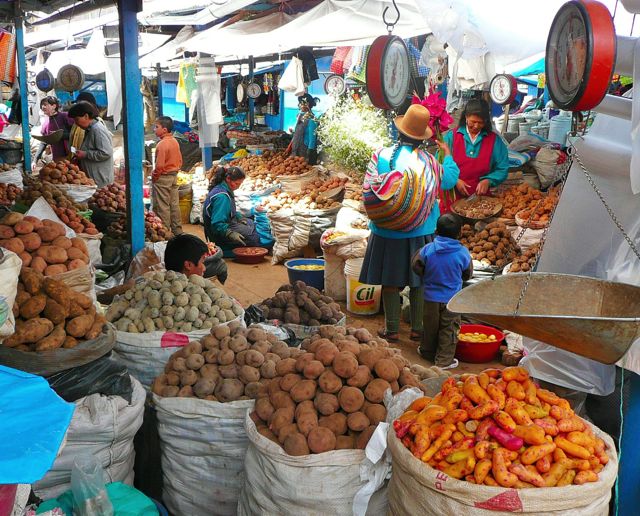 Tuber market, Cusco, Peru
Tuber market, Cusco, Peru
◊
For tuber cultivation information, see the bottom of this page ⇓
___
Note: Many of our tubers are only available in limited quantity, annually during the winter months (December through March/April),
check each listing for availability.
Please email to confirm stock before ordering, benkamm@monitor.net
___
We have limited seed of a few other Andean Food Crops listed after the Tuber offerings [see below Ullucus ↓ ].
__
See our Specimen Plant List for other Andean edibles and offerings.
__
Page updated 1/18/25
♠
Andean Tuber Crops
Arracacia xanthorrhiza ‘PR’ “Arracacha” “Apio”
Apiaceae. Perennial celery-like plant with edible leaves. Forms clusters of large cream colored roots that are edible raw or cooked, a delicious flavor somewhere between a potato and carrot. An ancient cultivar grown throughout the mid elevation Andes. Not as common as it once was as “civilized” plants such as carrots take its place. For over a hundred years it has been grown in Puerto Rico as “Apio”, though cultivation is declining there as well. We offer clones from PR genetics. Z8 if very well mulched
NOTE: Our stock was badly damaged the last few years and we nearly lost all of our plants. We likely won’t have our surviving plant large enough to propagate until summer 2025 or later — check back.
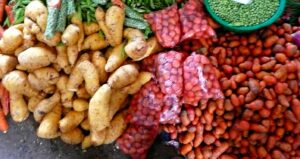 ↑ Arracacia on the left, Ullucus tuberosus on the right; Caraz, Ancash, Peru ↑
↑ Arracacia on the left, Ullucus tuberosus on the right; Caraz, Ancash, Peru ↑
___
Bomarea aff. ovata BK14513.17 “Sullu sullu”
Alstroemeriaceae or Liliaceae. Ornamental twining vine with annual stems to 8’+; perennial clusters of round edible tubers, 1-3″+ diameter. Green ovate leaves to 3″, lightly fuzzy undersides. Umbels of 5-12+ showy, funnel shaped flowers to 1″ long, outer tepals rose to pink with a green tip. Inner tepals 1/4″ longer than outer, base yellow, tip green with a few dark spots, inner side heavily flecked with black striations. red-pink midstripe. Ovary and pollen green. A little known and still mostly ignored ‘lost’ Incan crop, once cultivated for the tasty edible tubers and young asparagus-like shoots. Seed from plants growing in cloudforest near an Incan site, Sunchupata, Cusco Dept. Peru, 9700′. The Andes boasts 80+ species of these fantastic climbing lilies, in addition to edible tubers some species are used to treat venereal disease, infertility, kidney pain and hemorraging. Easily grown, well draining soil, sun to part shade with something to climb on. Drought tolerant. The vines/stems die back and go dormant during cold or dry spells. Plants currently winter dormant. Z8 or below if well mulched. Check the Specimen Plant List for other Bomarea species.
[ 5 ] → 1 ~ Plant/bulb 5+ years old $22.50 SOLD OUT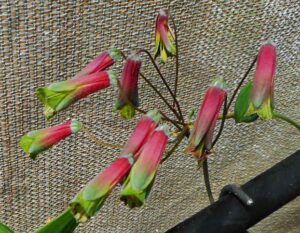
___
Canna edulis ‘Rojo’ “Achira”
Cannaceae. Ginger-like perennial monocot to 6′. Large attractive foliage, this strain has bronze and purple streaked leaves, dark reddish-brown seed pods and deep red lily-like flowers. Edible rhizomes. A cultivar throughout the mid-Andes. One of the “lost” crops of the Incas. The rhizomes are extremely rich in a large molecule starch and have been eaten since antiquity. Young shoots and immature seeds are also edible raw or cooked. Tolerant of diverse conditions, grows fastest in rich, moist soil. Often planted as a wind break. Z8b if mulched.
[ 5 ] → 2 ~ Rhizomes $14.50 each 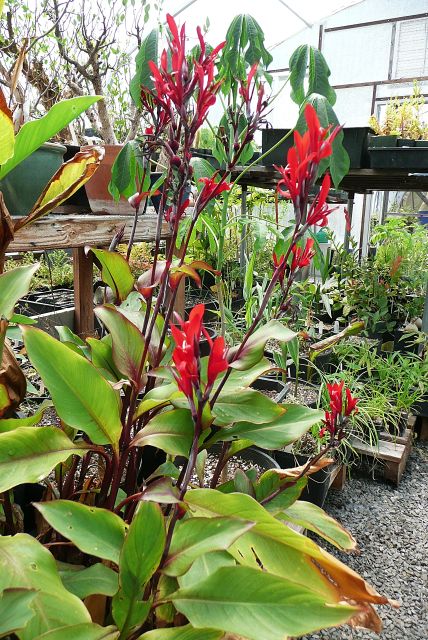
___
Canna edulis ‘Baldwin’s’ “Achira”
Dark green leaves and reddish flowers. Fantastic, thick, fast growing, yellow and pink banded rhizomes. We previously listed this as ‘Esmeralda’s’ from Oregon Exotics Nursery, but have since discovered it is in fact a previously unnamed, unreleased clone kept alive by our friend Tom Baldwin after OE closed.
Inquire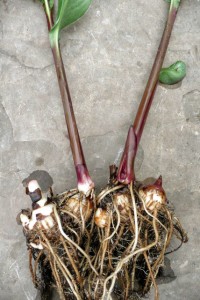
___
Canna edulis ‘Tarija’ “Achira”
Seed grown from plants farmed for millennia in Tarija, southern Bolivia. Fast growing rhizomes, bright green leaves, red flowers. Z8b if mulched.
Inquire
___
Canna edulis ‘Verde’ “Achira” ♥ New this season ♥
This heirloom strain has deep green leaves, slender red flowers flecked with orange and lime-green seed pods. True from seed. Z8b if mulched.
[ 5 ] → 2 ~ Rhizomes $13.50 each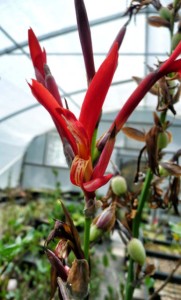
___
Lepidium peruvianum ‘Yellow’ “Maca” ♥ New this season ♥
Brassicaceae or Cruciferae. A radish or turnip like plant that is the highest altitude cultivar in the world, grown in the Andes at elevations over 14,000 feet. An ancient food/medicine that has been farmed for nearly 6,000 years. Incredibly nutritious, considered an energizing aphrodisiac and immunostimulant. Thrives in very harsh conditions, poor, cold soils with minimal water. Little work has been done growing this plant outside the Andes. Seed from a yellow root form that shows some tolerance for low elevation cultivation. Surface sow, germinates best under cool conditions. Z5b
[ 5 ] → 2 ~ Packet of 20–30+ seed $9 each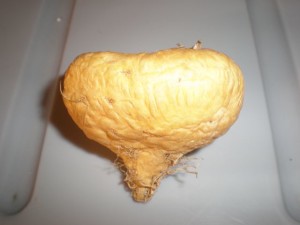
___
Lepidium peruvianum ‘Black’ “Maca” ♥ New this season ♥
Coveted heirloom variety with black colored roots from the remote maca fields of highland Peru. Z5b
[ 5 ] → 2 ~ Packet of 20–30+ seed $10 each
___
Lepidium peruvianum ‘Junin’ “Maca” ♥ New this season ♥
A mix of root colors: yellow, purple, red, etc. Seed from the high altitude maca fields of Junin, Peru, one of the major areas of cultivation for millennia. Z5b
[ 4 ] → 2 ~ Packet of 20+ seed $12 each
___
Lepidium peruvianum ‘Mix’ “Maca” ♥ New this season ♥
A mix of various colored roots from plants we have grown here in California. Z5b
[ 5 ] → 2 ~ Packet of 20–30+ seed $9.50 each
___
Mirabilis expansa ‘Seedling’ “Mauka” “Miso” “Tazo”
Nyctaginaceae. Herbaceous perennial to 2–3′, simple leaves. White to pink-red small flowers. Branched subterranean stems/tubers, thick, succulent and edible. Seed grown plants that vary from white/yellow to red skinned roots with white to reddish flowers and stems. This is the rarest, least understood of the Andean tubers, known to science since the 1960s. Only known from 3 disparate locations — north of La Paz, Bolivia, near Cajamarca, Peru and the highlands of Pichincha & Cotopaxi, Ecuador. This is most likely the result of the Incan policy of mitma; relocating entire ethnic groups throughout the Andes. Mauka’s tubers are protein rich and high in calcium, phosphorous and potassium. Much still needs to be discovered about the cultural needs of the plant but it has been surprisingly adaptable for us; tolerant of both wet and dry conditions, partial shade to full sun. Easily propagated by root division. Should be hardy to at least Z8 and likely Z7 if well mulched.
(You may request plants with white ‘Blanca’, or red ‘Roja’ roots.)
[ 5 ] → 1 ~ Plant/root division 3-4+ years old $32.50 SOLD OUT
___
Oxalis tuberosa “Oca”
Available late December until early April
Oxalidaceae. Round to cylindrical tubers 1–6” long. With hundreds of known cultivars in an alluring spectrum of colors from yellows to oranges, pinks and reds. Sprawling succulent stems to about 1’ tall with trifoliate clover-like leaves, yellow flowers. One of the easier Andean tubers to grow and second only to the potato in popularity. Cultivated for thousands of years, the tubers have a variety of flavors from crisp and lemony fresh to buttery and sweet when cooked. Still unknown as a food outside of South America with the exception of Mexico where it has been grown for over 200 years and New Zealand where it has been farmed recently. Grow similar to potatoes, the larger tubers develop late in the season after the Autumnal Equinox with cool weather and shortened daylength. Traditionally the tubers are exposed to sun and cold for several days after harvest to increase sweetness. Light exposure also enriches the vivid colors. Oca also make captivating ornamental plants. Our daughters love to snack on the sour leaves and flowers. If well mulched the tubers are hardy below Z7a.
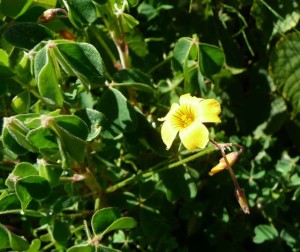
Each Oca tuber packets contain 2-4+ tubers
(Every 3 Oca ordered count as 1 plant for shipping costs.)
Oxalis tuberosa BK08516.8
Fat, round cylindrical tubers, yellowish with a pink blush, turn a deeper pink/maroon with light exposure. Fantastic non-acidic flavor. Our accession from Cusco region, Peru. We nearly lost this unique variety and are happy to offer it again.
[ 6 ] → 1 ~ Tuber packet $18.50 SOLD OUT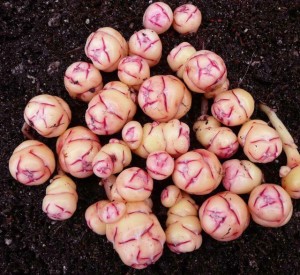
___
Oxalis tuberosa ‘Black’
Large cylindrical tubers, black eyes, dark red to nearly black skin, occasional pale yellow splotches, very prolific. A great selection from F.V. Keirsbilck. We nearly lost this gorgeous variety a couple years ago to rodents and weather extremes.
[ 6 ] → 1 ~ Tuber packet $17.50 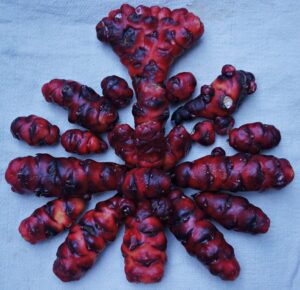
___
Oxalis tuberosa ‘Crema de Rosa’
Rounded to cylindrical knobby tubers, cream with a pink-red blush when exposed to light. Non-acidic and tasty. A La Paz, Bolivia collection from ethnobotanist Jim Bauml. We nearly lost this fantastic selection and are relieved to offer it once more.
[ 5 ] → 1 ~ Tuber packet $17.50 SOLD OUT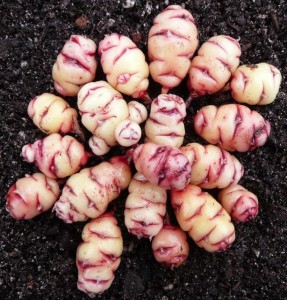
The following three Oca are $15.50 each or $42 for a set of any 3 varieties ⇓
Oxalis tuberosa ‘OE, Durazno’
Rounded, yellow/pale orange tubers, red eyes and pink/red-orange highlights, like a peach. From Oregon Exotics, the original name is lost.
[ 6 ] → 3 ~ Tuber packets $15.50 each SOLD OUT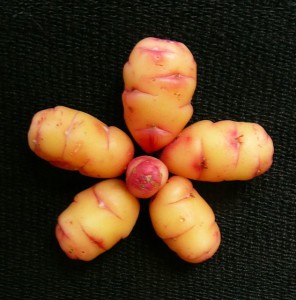
___
Oxalis tuberosa ‘Mexican Red’ ♥ New this season ♥
Dark blood red flattened cylindrical tubers. These are the deepest, purest red of any we offer. The name would suggest that this is one of the cultivars that has been grown in the mountains of Mexico for a couple centuries.
[ 4 ] → 2 ~ Tuber packets $15.50 each SOLD OUT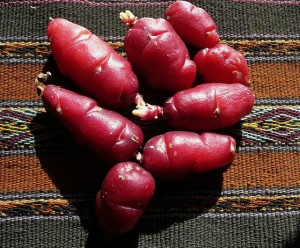
___
Oxalis tuberosa ‘Polar Bere’
Lumpy, rounded tubers, pure bone white to very pale yellow with light exposure. Mild sweet flavor.
[ 4 ] → 1 ~ Tuber packet $15.50 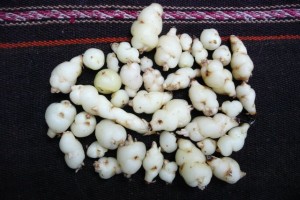
___
Oxalis tuberosa ‘Sunset’
Medium size orange to salmon-red cylindrical tubers, high yielding. A delightful acidic taste fresh, but cooks up mild.
[ 6 ] → 2 ~ Tuber packets $15.50 each January Sale! $13.50 each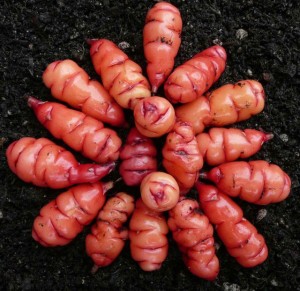
♣
___
Oxalis sp. BK14514.9 ♥ New ♥
A superb sub-shrub; colonies of erect, slender, semi-succulent, red stems to 24″+ high. Lightly pubescent, clover like edible leaves on long petioles. Panicles with dozens of relatively large, bright yellow blossoms with red streaks in the center and undersides, very sweetly scented when conditions are right; can bloom for months on end! Our seed collection from cloudforest understory and edges, Choquequirao, Cusco Dept., Peru, 10,000′. Resembles a more floriferous Oxalis tuberosa, minus the tubers. Despite the lack of tubers, this is a good candidate for Oca breeding. Easy to grow, tolerant of both wet and dry conditions, though definitely thrives in rich, moist soil with good drainage. An understory plant that tolerates sun but does best in filtered light. Regrows from roots after hard frost, especially if well mulched. The first time we’ve offered cuts of this attractive, highly floriferous, fruity-scented species. Unrooted cuttings root with minimal effort. Z9a/b
[ 4 ] → 2 ~ 8–10″ cuttings $24.50 each
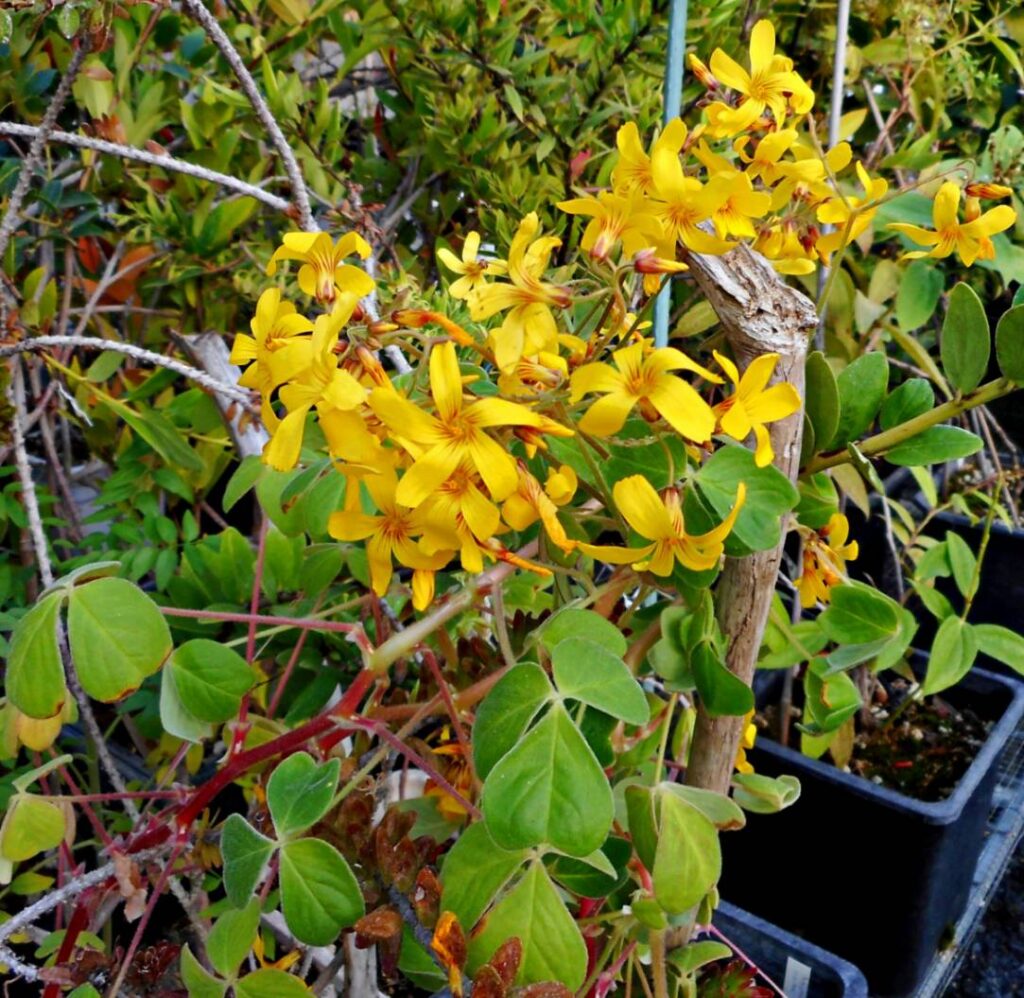 ↑ Oxalis sp. BK14514.9 in bloom ↑
↑ Oxalis sp. BK14514.9 in bloom ↑
___
Pachyrhizus ahipa “Ajipa” “Villu” “Andean Jicama”
Fabaceae. Semi-erect stems 1–2’ high with pubescent trifoliate leaves. Violet to white flowers and 3–4” bean pods. Swollen edible root, elongated to spherical, weighing up to 1 kilo. Another ancient domesticate, unknown in the wild. Cultivated in the Yungas, Ceja de Selva and warm interAndean valleys of Bolivia , Peru and northern Argentina, between 5–10,000’. Our seed is from Tarija, southern Bolivia. This is the Andean jicama, with sweet crunchy flesh similar to the larger Mexican jicama (Pachyrhizus erosus) many people are familiar with. Hardier, faster growing and more adaptable than Mexican jicama, this is a species that should do well in many gardens. Pest free, nitrogen fixing and daylength neutral. The root is rich in quality starch, minerals and protein. The foliage, pods and seeds contain the pesticide rotenone, moderately toxic to humans. Some plants show low rotenone content in the oil rich seeds, it is conceivable that an edible seed strain could be developed free of the toxin. About 4-6 months to harvest from seed, pinching the flowers back is said to increase root size. Prefers well draining soil and warmth. Sprout like beans. Cultivation of the plant is nearly extinct in Peru and Argentina and has been waning in Bolivia, integrating it into our gardens is an essential strategy for the conservation of this valuable ancient root crop. Z9/10a?
[ 6 ] → 2 ~ Packets of 5 seed $10 each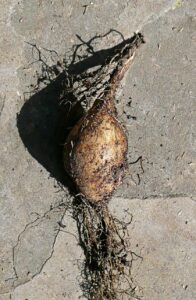
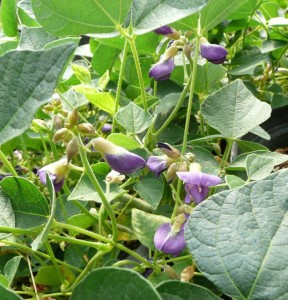
___
Smallanthus sonchifolius ‘Morado’ “Purple Yacon”
Asteraceae. This may be the variety originally introduced by Oregon Exotics as ‘Purple Puma’. As far as we can determine, this is also what has been distributed as ‘Red Yacon’. The 2-4′ annual stems and fuzzy leaves show some purple streaking. The orange-yellow mini-sunflowers are a little larger than other varieties. The knobby propagative tubers are a bright violet-purple to reddish-purple, the fat, yam- shaped, juicy storage tubers have a pink-purple to brown-purple skin and white flesh that sometimes infuses violet with light exposure. Surely rich in antioxidant anthocyanins. Yacon is a wonderful multi-use plant, traditionally grown throughout the Andes, it has also been introduced to Central America and is popular in New Zealand. The large storage tubers have a delicious juicy sweet taste, somewhat like a cross between jicama and watermelon. In the Andes it is thought of more as a fruit than a vegetable and, to increase their sweetness, the tubers are traditionally laid out to dry a little in the sun for a few days. Our kids love to crunch the tubers dug fresh from earth. The storage tubers are rich in fructooligosaccharides and are considered a prebiotic: that is, they feed the healthy bacteria in the gut–which improves overall health. The young vegetative growth is cooked similar to celery. The leaves are used as a blood-sugar balancing tea for diabetes. A molasses like syrup made from the roots is becoming popular as a beneficial sweetener. Easy to grow in most any garden, prefers sun and a rich soil. We supply propagative tubers for planting. Z7b or 8a if well mulched.
[ 6 ] → 1 ~ Plant/tuber $19.50 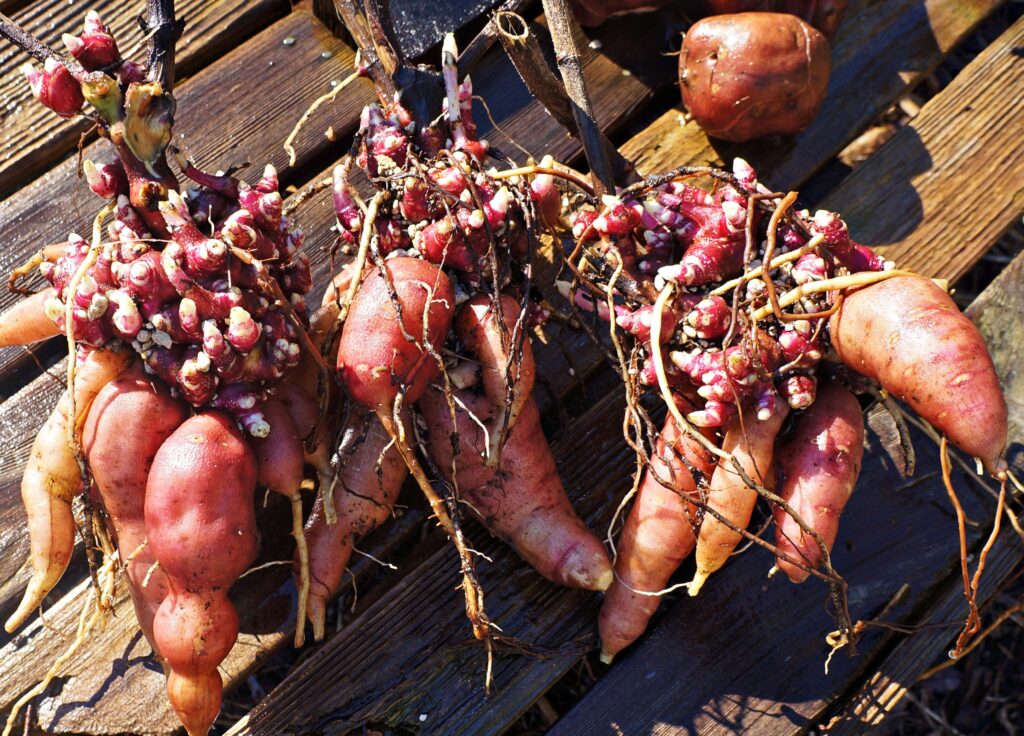
___
___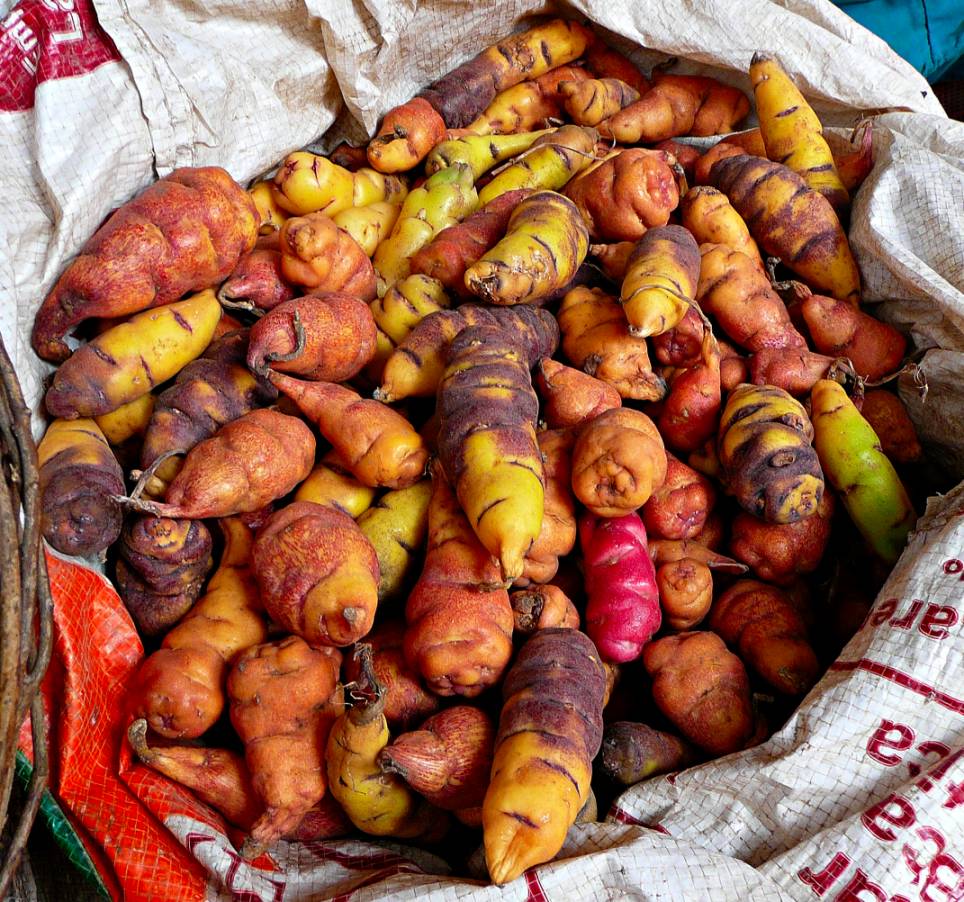 ↑ Tropaeolum tuberosum varieties, Cusco market, Peru ↑
↑ Tropaeolum tuberosum varieties, Cusco market, Peru ↑
___
Tropaeolum tuberosum SS15.C “Mashua” “Añu”
Tropaeolaceae. A rare and extraordinary seed grown selection from our 2015 breeding efforts with several heirloom cultivars and our accessions of the wild silvestre subspecies. The most exciting of these new seed grown Mashua. Long tubers to 8”+, pale pink to magenta and darker shades of purple. With light exposure, the colors even deepen to purple-black. Very prolific. The most beautiful Mashua tubers we’ve seen! Tubular orange flowers; the annual climbing stems to 8’ and rounded lobed leaves also take on lovely purple hues. Mashua is a high yielding root crop throughout the Andes; close relative to the garden nasturtium. A fantastic addition to any garden, easy to grow, highly ornamental, pest resistant and repellent. The tubers are cooked like potatoes and can have a slight peppery flavor. Shown to reduce testosterone with regular consumption. The leaves and flowers are edible too. We first introduced this unique new varietal about 5 years ago and since then have only offered it a couple times. Z7a when well mulched.
[ 8 ] → 1 ~ Tuber/plant $26.50 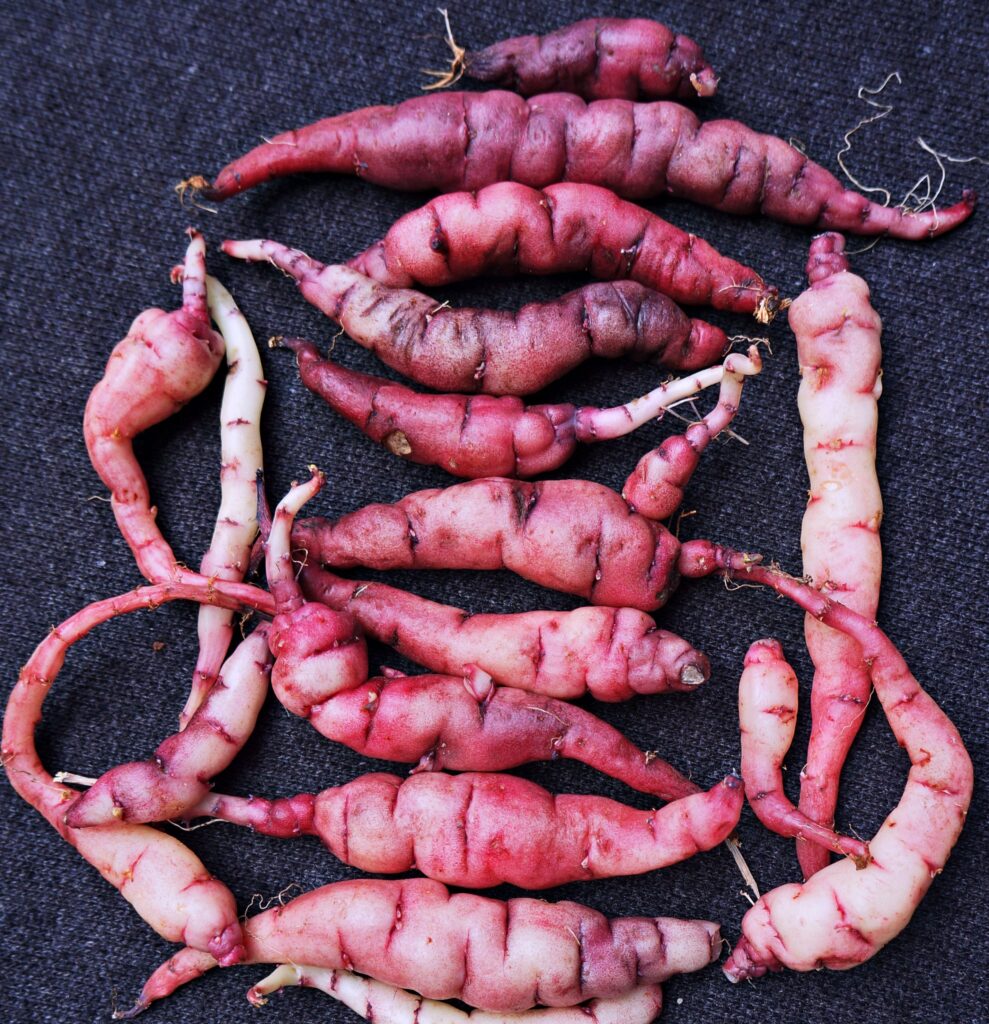
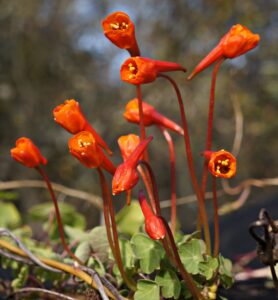
___
Tropaeolum tuberosum SS15.B “Mashua” “Añu” ♥ New this season ♥
Another seed grown selection from our 2015 breeding efforts with several heirloom cultivars and the wild silvestre subspecies. This one has cream colored tubers to 6″+ with purple eyes and occasional light spray of purple speckles. This one shows the the influence and hardiness of the wild subspecies genetics and looks somewhat similar to v. pilifera. Very productive so far. We’ve only offered this new variety once before. Z7a if mulched
[ 3 ] → 2 ~ Tuber/plants $22.50 each SOLD OUT
___
Tropaeolum tuberosum ‘Chilean Red’ “Mashua” “Añu” ♥ New this season ♥
Vine with purple stems. Round to cylindrical tubers; pale yellow, orange and deep red. Early in the season they unearth yellow and peach colored, the longer they stay in the ground the darker the red coloring. Fast growing and very productive for us. Z7a if mulched
[ 5 ] → 1 ~ Tuber/plant $18.50 SOLD OUT
___
Tropaeolum tuberosum v. lineamaculata ‘Puca-añu’ “Mashua” “Añu” ♥ New this season ♥
Elongated cylindrical tubers, yellow with heavy purple-red flecking and lines that often entirely cover the tuber. The vines also have dark purple stems. This description fits the true variety lineamaculata. Highly productive. Originally introduced by Oregon Exotics. Z7a when mulched.
[ 5 ] → 2 ~ Tuber/plants $19.50 each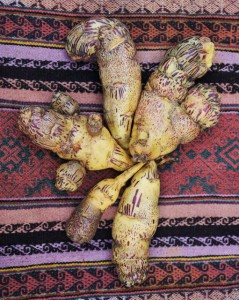
___
Tropaeolum tuberosum v. pilifera “Mashua Blanco” “Añu” ♥ New this season ♥
Vine with rounded lobed leaves, orange flowers. 2″ to 6″+ white to cream colored edible tubers with purple eyes and with light exposure: fine purple speckles near the stem. According to Cardenas this white variety originates in Columbia. This is probably the easiest and most productive of the Mashua for us, though the tubers are not as showy as other varieties. Z7 if well mulched.
[ 4 ] → 2 ~ Tuber/plants $15.50 each SOLD OUT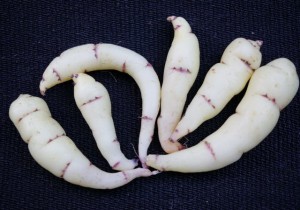
___
Tropaeolum sp. BK09510.1 ♥ New this season ♥
Scrambling or climbing vine to 10–15’+. Unusual rounded leaves with amazing veination and large deep yellow/orange flowers with dark-orange veins and blotches, all parts edible. Reminiscent of the common cultivated nasturtium, yet decidedly distinct. Our collection from plants growing at the ruins of Tumshukaiko, a little known site near Caraz, Ancash, Peru, that was occupied pre-Chavin up to Incan times. Prefers sun, perennial in mild climates, otherwise grow as an annual. Makes a lovely garden plant, let it sprawl or give it a fence or trellis to grow on. While it does not seem to form tubers, it still has potential for Mashua breeding! Like other Andean Tropaeolum, seed can germinate erratically over 1–12+ months. Z9b/10a
[ 5 ] → 2 ~ Packets of 5 seed $10 each
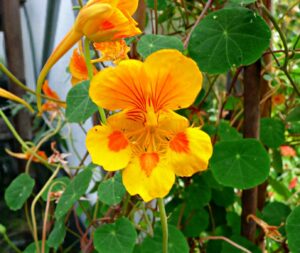
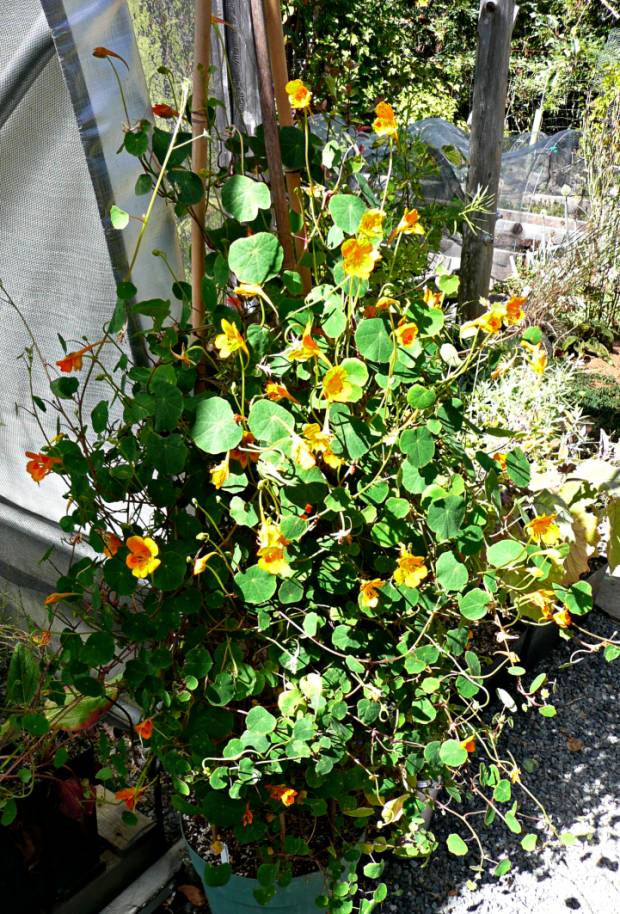 ↑ Tropaeolum sp. BK09510.1 in cultivation ↑
↑ Tropaeolum sp. BK09510.1 in cultivation ↑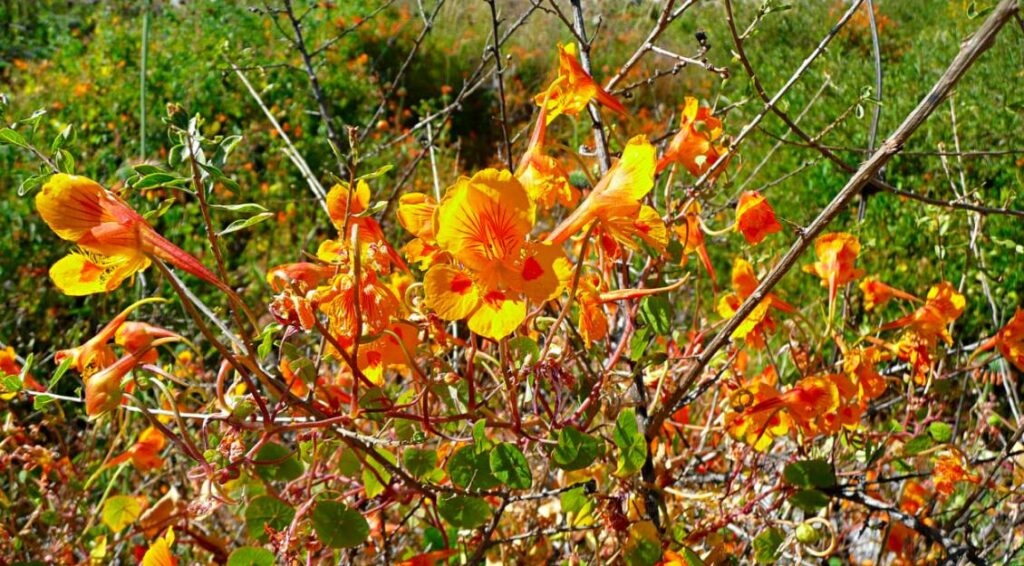 ↑ Tropaeolum sp. BK09510.1 in habitat ↑
↑ Tropaeolum sp. BK09510.1 in habitat ↑
___
___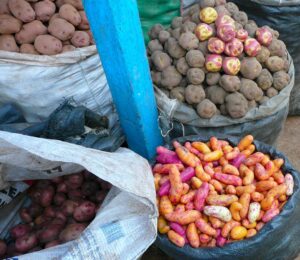 ↑ Ullucus tuberosus [lower right], Cusco market, Peru ↑
↑ Ullucus tuberosus [lower right], Cusco market, Peru ↑
___
Ullucus tuberosus “Papa Lisa” “Ulluco” “Melloco”
Basellaceae. Hundreds of cultivars with 1–4”+ round to cylindrical tubers, a delightful array of bright colors. Edible spinach-like rounded leaves on short sprawling stems to 12”. One of the most delectable of all the Andean tuber crops, yet practically unknown in the U.S. Crisp and buttery in flavor. Shown to have antiviral properties. Contains triterpenoid saponins which may help with hypoglycemia. Like Oca, the tubers only develop late in the season. Tuber production is best in areas with a slow transition from Summer to Autumn. A little fussy, but have been adaptable to northern California. Hardy below Z7a when well mulched.
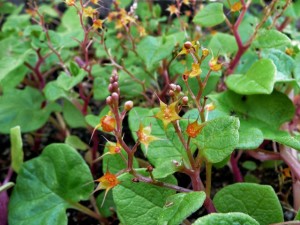
The following Ulluco are $17.50 each or $88 for a set of 6 varieties
Each tuber packets contain 2-5 small tubers
(Every 3 Ulluco ordered count as 1 plant for shipping costs.)
Ullucus tuberosus BK08607.1
1–2”+ round “pica de pulga” type; yellow to orange with fluorescent red to pink spots and stars. The name means “flea bitten”. From a market in Chulumani, Yungas, Bolivia.
[ 5 ] → 2 ~ Tuber packets $17.50 each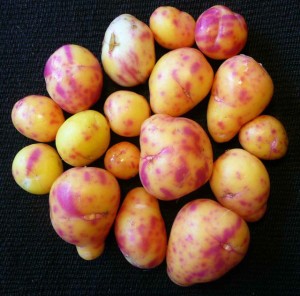
___
Ullucus tuberosus BK10425.2
1–4”+ grub-like cylindrical yellow tubers with fluorescent pink splotches. Cultivated near Patacancha, Cusco Dept., Peru.
[ 6 ] → 2 ~ Tuber packets $17.50 each
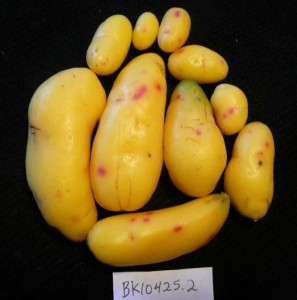
___
Ullucus tuberosus BK10429.1
1-3″+ pale to bright yellow round to cylindrical tubers with slender pale pink eyes. From Grimalda Quispe, Chinchero, Cusco Dept., Peru.
2 ~ Tuber packets $17.50 each
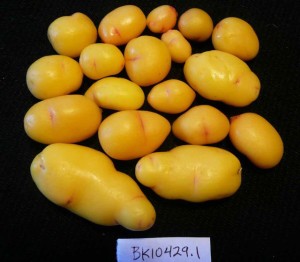
___
Ullucus tuberosus BK10429.2
1–2”+ Pale to darker yellow lumpy oblong tubers, occasionally with a purplish blotch. From our friend Grimalda Quispe in Chinchero, Cusco Dept., Peru. In addition to eating she says the sliced tubers are used on bug bites, burns and swellings; including swollen lymph.
[ 5 ] → 3 ~ Tuber packets $17.50 each
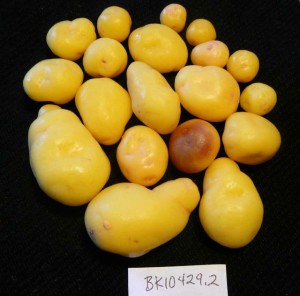
___
Ullucus tuberosus BK151014.10
Bright lime-green round tubers to 1-3″. Our accession from a market in Jujuy, northern Argentina; we were told they are farmed near the Bolivian border.
[ 6 ] → 2 ~ Tuber packets $17.50 each
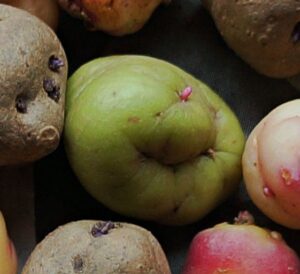
___
Ullucus tuberosus ‘Chugua Roja’
Rounded rose-pink tubers to 1-2″+. A prolific grower from Boyaca, Columbia. Seems a bit more adaptable to warm conditions than some varietals.
[ 8 ] → 3 ~ Tuber packets $17.50 each January Sale! $15.50 each
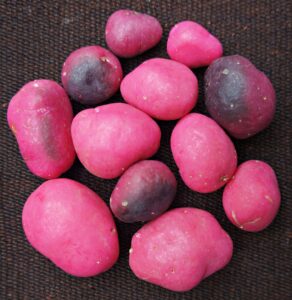
___
Ullucus tuberosus ‘Illimani’
Chunky tubers, bright yellow with occasional pink speckles, 1-3″+. Cultivated on the high altitude slopes of Apu Illimani, La Paz, Bolivia.
[ 4 ] → 2 ~ Tuber packets $17.50 each January Sale! $15.50 each
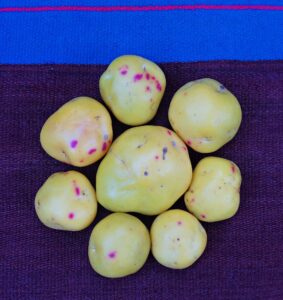
___
Ullucus tuberosus ssp. aborigineus “Ulluco Silvestre” “Wild Ulluco”
Trailing vine to 2–10’+ with heart-like edible leaves. 1/2–2”+ round or oblong tubers, varying from white to pink or lavender, turning almost purple-brown with light exposure. This is considered the wild form or ancestor of the cultivated Ulluco. In our experience the tubers are just as edible as the cultivars and only slightly smaller. The leaves are delicious like spinach. Cultivated Ulluco very rarely sets seed and this wild subspecies, which seeds more readily, could be used in breeding programs. It has been speculated that it was used in breeding new varietals by the Incas. Grow as you would other Ulluco, but give more room for the vine. A good source for edible greens, the leaves are larger and more abundant than the cultivars. In our initial trials one pea sized tuber produced nearly 4 oz of tubers in a season. Our original introductions, otherwise unknown in cultivation. Z6 to 7 if mulched.
Also see – https://www.microcosmssacredplants.org/plant/ullucus-tuberosus-aborigineus/
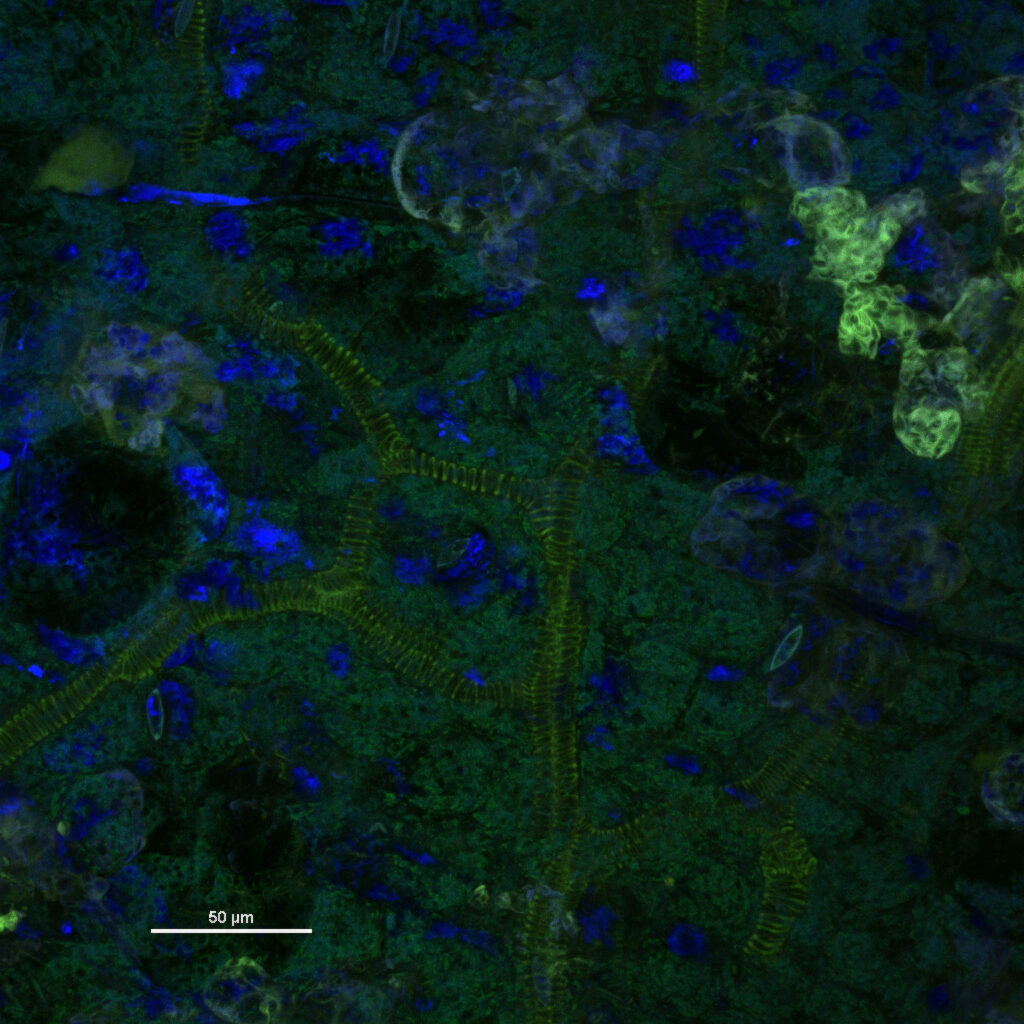 Ullucus tuberosus spp. aborigineus scanned at St. Lawrence University’s Microscopy & Imagery Center, from Microcosms: A Homage to Sacred Plants of the Americas, used with the permission of Jill Pflugheber & Steven F. White, © 2023.
Ullucus tuberosus spp. aborigineus scanned at St. Lawrence University’s Microscopy & Imagery Center, from Microcosms: A Homage to Sacred Plants of the Americas, used with the permission of Jill Pflugheber & Steven F. White, © 2023.
The following Wild Ulluco are $16.50 each
Each tuber packets contain 3-6+ small tubers
(Every 3 Ulluco ordered count as 1 plant for shipping costs.)
Ullucus tuberosus spp. aborigineus BK10426.5
Trailing vine to 24”+. Chunky lavender tubers to 2”+. Growing in Incan stone terrace walls with Peperomia rotundata. Halfway from Pumamarca to Munaypata, Cusco, Peru, 10,500’. This accession was made at one of the most heavily terraced mountainsides we’ve seen in all of the Andes — with over a thousand stone terraces it must have been a site of intensive agriculture.
Unavailable this season
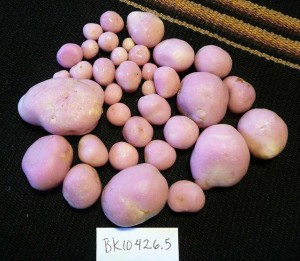
___
Ullucus tuberosus spp. aborigineus BK10426.6
Sprawling vine to 36”+. Odd shaped lavender-pink tubers to 2.5”. Growing amongst dilapidated Incan walls above Munaypata, Cusco Dept., Peru, 10,400’.
[ 5 ] → 2 ~ Tuber packets $16.50 each 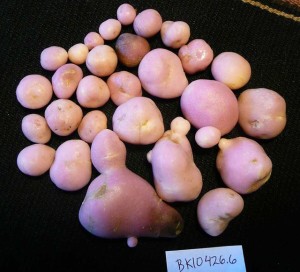
___
Ullucus tuberosus spp. aborigineus BK10427.5
Vine to 24”+, small pale pink tubers. Growing amongst boulders with Bomarea and Fuchsia apetala, above Patacancha village, Cusco Dept., Peru, 13,000’. Should be extra hardy.
Unavailable this season
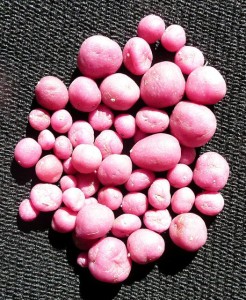
___
Ullucus tuberosus spp. aborigineus BK10509.6
Long dangling vines to 20 feet or more, hanging on rocky cliffs next to a waterfall, Inkallajta, Cochabamba, Bolivia, 10,000’. Pale to dark lavender tubers, round to oblong. These were the longest vines we’ve seen from the wild ulluco. Reported to be utilized in the region for gastrointestinal problems. This varietal may be more adaptable to warmer conditions than the others.
We seem to have completely lost this accession in 2024. If you are growing BK10509.6, please contact us!
___
Other Andean Food Crops
♥ All New this season ♥
Seed can ship internationally!
Amaranthus caudatus ‘Cusco’ “Kiwicha”
Amaranthaceae. Annual with showy red-purple flower spires, edible leaves. The small yellow-white seed is a highly nutritious grain that has been cultivated for thousands of years in the Andes. Heirloom strain from Cusco Dept., Peru. Easy to grow and fun.
[ 5 ] → 2 ~ Packets of 50+ seed $8 each
___
Chenopodium pallidicaule ‘Cochabamba’ “Kaniwa” “Iswalla Hupa”
Chenopodiaceae. Weedy annual 1–2’ tall. A semi-domesticate, cultivated in the altiplano regions of Peru and Bolivia. Grows where its close kin quinoa and kiwicha (or any grain) will not–dry, salty, and cold regions over 13,000’. The small seed is extremely nutritious, about 16+ percent protein, saponin free. Even the leaves are protein and calcium rich. Unknown outside the Andes, worth experimenting with as a crop. Seed from Cochabamba, Bolivia. Z6?
[ 6 ] → 3 ~ Packets of 60–100+ seed $8 each
2 ~ 1 gram seed $20 each
Chenopodium pallidicaule ‘Cusco’ – Seed from Cusco Dept., Peru.
[ 4 ] → 3 ~ Packets of 50–75+ seed $8 each
Chenopodium pallidicaule ‘La Paz’ – Seed from La Paz, Bolivia.
[ 6 ] → 3 ~ Packets of 60–100+ seed $8 each
[ 2 ] → 1 ~ 1 gram seed $20
___
Chenopodium quinoa ‘Quri’ “Gold Quinoa”
Rare heirloom Peruvian quinoa with pale yellow to deep orange seed. Annual stalks 4–8′ tall, the flower heads are a medley of color, from yellow to pinks and pale purples. A long season variety. “Quri” is the Quechua word for “gold.”
[ 5 ] → 2 ~ Packets of 50–75+ seed $9 each
[ 4 ] → 2 ~ 5 grams seed $30 each 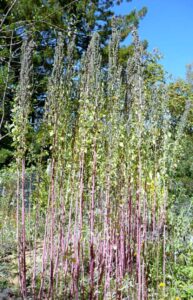
___
Chenopodium quinoa ‘Supha Aqu’ “Quinoa”
3–4’ annual. Rounded flower clusters and seedheads. The stems, leaves and flower panicles range from green-blue to pink-purple. Fat, sand colored, nutritious seeds. A short season heirloom quinoa from Aymara communities in northern Chile. Should be be adaptable to arid climates.
[ 5 ] → 3 ~ Packets of 50–75+ seed $8 each
2 ~ 5 grams seed $28 each
___
Chenopodium quinoa v. melanospermum BK10505.2 “Ajara” “Quinoa negro”
Heirloom Bolivian quinoa with blackish seed and rich flavor. Bolivia is the world’s major producer of this extremely nutritious and delicious grain. Seed from Cochabamba, Bolivia.
[ 4 ] → 3 ~ Packets of 50–75+ seed $10 each
___
Cucurbita ficifolia ‘Tarija’ “Lacayote” “Zambo”
Cucurbitaceae. Tendrilled vine 15–40’+ with big fig-shaped leaves. Large yellow flowers. Watermelon-size squash, dark green with white striations. Seed originally from Tarija, Bolivia. New shoots, leaves and blossoms are eaten. Immature fruit are eaten like summer squash. The carb rich, white flesh of mature fruit can be cooked just like any wintersquash and has a very sweet flavor–often used in making pies, confections, jams and fermented into alcoholic drinks. Studies show the squash to effect hypglycemia and it’s used for diabetes. The large edible seeds are rich in fat and protein. Cultivated throughout Central and South America for thousands of years, archaeological evidence suggests Peru as the origin of domestication. Grow as an annual like pumpkins, needs a long season–a short day bloomer. May perennialize in mild climates where the vines become semi-woody and can be propagated by cuttings. Doesn’t hybridize well with other squash. Mature fruit can keep for several years if kept dry, the flesh gets sweeter with age. Z9b/10a
[ 5 ] → 2 ~ Packets of 5 seed $8 each
___
Cyclanthera explodens BK09506.2 “Achukcha” “Wild Caigua”
Cucurbitaceae. Clambering tendrilled vine with 3-lobed leaves, small yellow/white flowers and 1–2” inflated fruit covered in small prickles. When the fruit is fully ripe it “explodes”, launching the seed up to several meters. This wild caigua is often seen for sale in the local Andean markets, being used as a delicious food and medicine the same way as the cultivated species (see below). Huaraz, Ancash Dept., Peru. Will perennialize in mild climates, otherwise grow like an annual cucumber, giving the vine plenty of room. Easy to grow. Z9b
[ 5 ] → 2 ~ Packets of 6 seed $8 each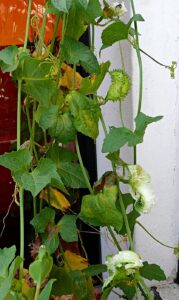
___
Cyclanthera pedata ‘Tarija’ “Caigua”
Tendrilled annual vine with palmate leaves and peculiar inflated green fruit to 6”, often lightly prickled. A popular food in South America, another “lost” Incan crop, with a flavor similar to artichoke. The hollow fruit is cooked and eaten, usually stuffed with vegetables and meat or added to soups. The flesh is also an important medicinal, being a strong anti-inflammatory and flushing cholesterol from the body. The whole plant is considered a brain tonic. A delectable vegetable that deserves much wider cultivation. Grow like cucumber. Heirloom strain from Tarija, Bolivia. Vigorous vine, smooth skinned fruit. Z9b
[ 5 ] → 2 ~ Packets of 10 seed $8 each
[ 2 ] → 1 ~ Packet of 50 seed $28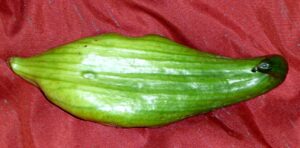
Cyclanthera pedata BK10505.1 – Our accession of an heirloom strain from Cochabamba, Bolivia. Large fruit, occasional light prickles. Produces very well for us.
[ 4 ] → 2 ~ Packets of 10 seed $9 each
___
Lupinus mutabilis “Tarwi”
Fabaceae. Another ancient Andean domesticate. Upright annual shrub 3–6’+ tall. Digitate leaves and large spires of bright blue flowers with an exquisite honey scent. 2–5” pods with 1/3” round white beans. Edible lupine grown throughout the Andes up to 13,000’. Once formed an integral part of the highland diet, intercropped or rotated with tuber crops, but now being supplanted in many regions with introduced fava beans. Protein rich, up 50% with as much as 20% beneficent oils. The seed contains bitter alkaloids which need to be leached by soaking for 1–2 days prior to eating. Toasted and relished as snacks, added to soups and stews, made into milk and pudding, even ground into flour for use in baked goods. This legume is an excellent green manure and nitrogen fixer, up 300 lbs an acre. Young plants are frost tender, while larger plants are tolerant of some cold. 4–5 months from seed to seed, but will continue to seed heavily for an additional 5 months if climate permits. Z9a/b
[ 5 ] → 3 ~ Packets of 10 seed $8 each
[ 3 ] → 2 ~ Packets of 50 seed $28 each
___
Physalis peruviana BK09507.2 “Aguaymanto” “Cape Gooseberry” “Goldenberry”
Solanaceae. Herbaceous plant to 2’. Downy leaves, yellow flowers and cherry size yellow fruit encapsulated in a papery husk. The sweet fruit is relished throughout the Andes, often made into jams. The plant is drunk as a tea as a diuretic, anthelmintic and to dilate the uterus during childbirth. Can survive some frost, regrowing from the roots in Spring, otherwise treat as an annual. This Andean weed is now being marketed in the U.S. as “Inca Berry” or “Goldenberry”. Collected near the ancient ruins of Chavin de Huantar, Ancash Dept., Peru. Z8b
[ 5 ] → 3 ~ Packets of 30–40+ seed $8 each
___
Tagetes multiflora? BK14511.1 “Huacatay” “Chiqchipa”
Asteraceae. Annual or perennial species to 1–2’. Attractive densely pinnate leaves with a strong anise-like scent. Clusters of mini-marigold orange flowers. Seed collected near the Incan huaca of Killarumiyoq, Cusco Dept., Peru, 11,500’. Attracts pollinators and repels soil nematodes. Brewed as a digestive tea. The leaves are used as a popular Andean spice/condiment. This is the favored “huacatay”, the flavor/scent of this plant is is much preferred over T. minuta which has been popularized as “huacatay” in North America. Easy to grow. Z9a/b
[ 5 ] → 2 ~ Packets of 15–20+ seed $10 each
___
Vicia faba ‘Ojo de Dios’ “Fava Bean”
Fabaceae. Annual with erect stems 2–3’ high. White and black flowers. Bean pods enclosing beige or brownish-green 1”+ beans, of which about 75% have a circular eye-like mark on them. Seed originally from Matucana, Lima Dept., Peru. Fava bean is an old world food and cover crop that was brought to South America in the 16th century and has since become an important staple crop throughout the Andes. A unique heirloom strain. Z9b
[ 6 ] → 2 ~ Packets of 12+ seed $8 each
___
♣
Ordering Andean Tubers:
Tubers orders can be combined with other items — specimen plants, books, auction plants, products, etc.
Tubers and seed of Andean Crops are only available in limited quantity,
please email first to confirm availability – benkamm@monitor.net
& provide your full shipping address in the email.
◊
Shipping & Handling for Andean Tubers & Plants (USA only)
First Class Priority Mail = $10.00 for the first plant, $2 each additional plant.
[↑ for Oca and Ulluco, every 3 tuber packets count as 1 plant for shipping ↑]
Express mail = Inquire for current costs
◊
Heat Packs: For folks in colder regions, we can ship your tuber/plant order with a Heat Pack for a $5 fee per pack.
◊
Shipping and Handling for Seed Packets
First Class Mail USA: $5.00 (seeds ride free when ordered with plants/tubers)
International: First Class $20, or Priority Mail $45 (quickest, most secure, recommended!)
__
California residents add 7.25% sales tax. Sonoma county residents 8%.
___
GIFT CERTIFICATES are excellent gifts: available for any amount, please inquire
♠
___
Cultivation of Andean Tubers
General information for all: Plant tubers 2-6″ deep. They all are tolerant of a wide range of soils, but definitely grow best in a relatively rich, well draining soil. We use 25% pumice stone, 10-15% sand and the rest compost/garden loam. Gophers are particularly fond of all these plants, so we grow these in half wine barrels or raised beds with wire mesh on the bottom. In the colder climates, several inches of mulch will help assure tuber survival through heavy frosts. In climates below Z7, the tubers can be overwintered in moist coir or sand in a cool place, then replanted at the start of the growing season. Though tolerant of a little shade, all do best in a sunny location.
Canna: This is the least cold hardy them all, but can still tolerate Z8a or even 7b if very well mulched. Achira is also much more tolerant of extreme heat and wet or even soggy soil. The rhizomes are best harvested after the tops of the plant have died back from frost or a dry period. Make sure to replant a few of the nippled growing tips of the rhizome for continued harvests.
Oxalis: One of the most adaptable of the tuber crops. Some varietals seem more tolerant of high Summer temperatures than others. Since tuber production does not begin until after the Autumn Equinox when the daylength shortens and the days cool, the largest tubers are produced if you can keep the tops protected from hard frost (they are tolerant of light frost) and growing as long as possible (this goes for Tropaeolum and Ullucus as well.) If you do not live in an area with a long mild Autumn season, you have a couple options. One method is to stake some hoops over the plants with frost protectant fabric or even greenhouse plastic. One other trick is to cover them with shade cloth a few weeks prior to the Equinox to simulate shortened daylight and encourage early tuber forming. We are finding that well before the shortened daylength it is good to mound extra soil around the stems, as you would potatoes, to encourage additional tuber formation. The tubers can be harvested after the tops of the plant finally die back. In general, the more cold the tubers are exposed to the sweeter they become, so a late harvest is usually preferable. Traditionally the tubers are exposed to sun and cold for several days after harvest to break down any oxalic acids and increase sweetness. Exposure to light also enriches the vivid colors. Tubers can be left in the ground for next years plants, or stored tubers can be replanted in the Spring. Like potatoes, the tubers can be cut into pieces for propagation.
Smallanthus: One of the most adaptable to warmer climates, some clones have even proven themselves in the tropics. It’s important to differentiate what’s the propagative tuber and what’s the edible storage tubers. The propagative tuber (what you’d receive from us) is knobby, eventually clustering, often cream colored, brown, or even purple when exposed to light. It looks very much like its close relative the sunchoke (jerusalem artichoke). The edible storage tubers grow off the other tubers and are long (to 10″+), smooth, usually brown or white, and shaped like yams. New plants cannot be propagated from these. The propagative tuber clusters can eventually grow quite large (we’ve had them basketball size), and these can be broken up to further propagate the plant. Some clones are very sweet harvested any time of the year, while others are a bit sour until exposed to repeated frosts.
Tropaeolum: Best given something for the vines to climb on. In general, mashua dislikes heat, preferring a long cool and moist season. Most varieties are daylength sensitive for tuber production, after the Autumn Equinox they should be cultured similar to Oxalis (see entry above). The ‘Ken Aslet’ variety has been grown as an ornamental for some time and is not particularly sensitive to daylength for tuber forming, though greatest tuber formation is still Autumn. Vegetative growth is tolerant of mild frost, but dies back to the tubers after heavy frost. Flowers are formed late in the season, but can be encouraged earlier by holding back water.
Ullucus: A little more challenging than the others, but well worth any effort. Most varieties resent too much heat. They also seem to be sensitive to being transplanted into overly rich “hot” soil, often rotting. The best treatment is gradually applying small amounts of compost/fertilizer as a mulch throughout the growing season. Even more than oca, they only produce their lovely tubers well after the Autumn Equinox, sending out small stolons that slowly grow into tubers. See the Oxalis entry above for additional growing info. Unlike oca, the bright tuber colors quickly turn green when exposed to light, though unlike true potatoes, they are still safe to eat.
♣
Inquire for additional cultivars.
See our Specimen Plant List for other Andean edibles and offerings.
♣
Sacred Succulents, PO Box 781, Sebastopol, CA 95473 USA
Email: benkamm@monitor.net
__
To receive our periodic (every 4-6 weeks) emails listing new plants & seeds, specials, news from our gardens, greenhouses & travels sign up at –
http://lists.sonic.net/
__
Public Domain Pledge
An important terms of business note to all our customers:
In order to be in line with our mission to support the preservation of botanical biodiversity, following the lead of J.L. Hudson Seeds and in recognition that the biodiversity of the Earth is the common heritage of all life, all of our seed and plant offerings are now Public Domain. This means that all plants and seeds are supplied solely under the following conditions: We expressly prohibit the use of any seeds or plants supplied by us, or their progeny, in any form of genetic engineering, breeding, or research which will result in any form of life patent, variety protection, trademarks, breeder’s rights or any form of intellectual property applied to living things which would compromise the Public Domain status of the seeds, plants, their progeny and any genetic material therein. We expressly prohibit the transfer to any third party of any seeds, plants, their progeny or any portion of their genetic material without these prohibitions in place. Commercial propagation is encouraged, but in the unlikely event that large-scale commercial distribution is achieved, benefit-sharing along the path towards the source, in accordance with the spirit of the International Convention on Biological Diversity, will be undertaken. Thank you for your understanding and support!